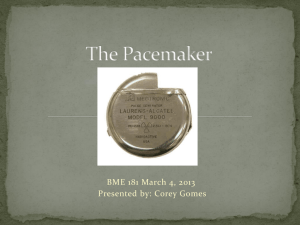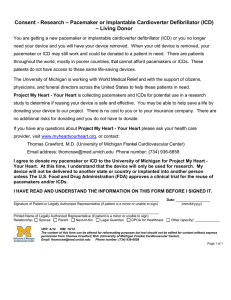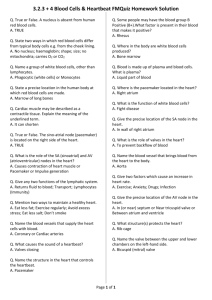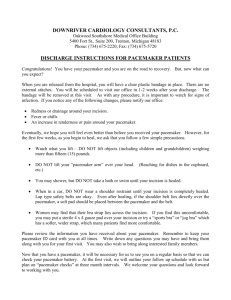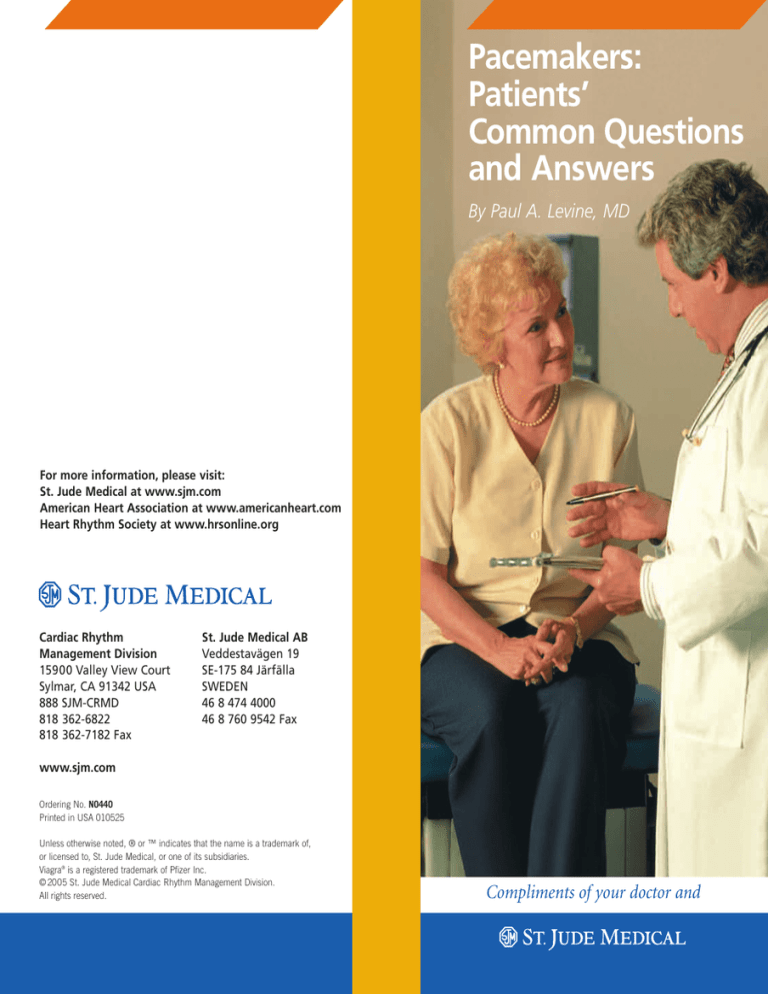
Pacemakers:
Patients’
Common Questions
and Answers
By Paul A. Levine, MD
For more information, please visit:
St. Jude Medical at www.sjm.com
American Heart Association at www.americanheart.com
Heart Rhythm Society at www.hrsonline.org
Cardiac Rhythm
Management Division
15900 Valley View Court
Sylmar, CA 91342 USA
888 SJM-CRMD
818 362-6822
818 362-7182 Fax
St. Jude Medical AB
Veddestavägen 19
SE-175 84 Järfälla
SWEDEN
46 8 474 4000
46 8 760 9542 Fax
www.sjm.com
Ordering No. N0440
Printed in USA 010525
Unless otherwise noted, ® or ™ indicates that the name is a trademark of,
or licensed to, St. Jude Medical, or one of its subsidiaries.
Viagra® is a registered trademark of Pfizer Inc.
© 2005 St. Jude Medical Cardiac Rhythm Management Division.
All rights reserved.
Compliments of your doctor and
Q: Where in the body are pacemakers
implanted? How do they work?
A: What is generally considered a pacemaker
is actually a pacing system made up of four
important components—the pulse generator,
the pacing leads, the programmer, and, of
course, the patient. The pulse generator is
implanted in the upper chest (on either side
of the body) just below the skin near the
collarbone. The leads are thin wires that are
inserted through a vein and connect the
generator to the heart. The pulse generator
contains the battery and the electronic
circuitry, or brain, which directs the battery
to send electrical pulses through the leads.
In turn, this stimulates the heart and causes
it to beat at a normal rhythm. The leads
also pick up the patient’s own heart rhythm
and transmit this information to the
generator, which adapts its responses
Sensing/Pacing
Lead System
Sensing/Pacing
Lead System
Pulse Generator
to the patient’s needs. The final component
is an external tabletop computer called a
programmer. A doctor can use this to
change pacemaker settings during followup patient visits without the need for
further surgery.
Q: How do people know if they need one?
A: A pacemaker is prescribed when the heart’s
electrical conduction system malfunctions
and causes the heart to beat too slowly.
Sometimes, a dangerously slow rhythm
is discovered during a routine checkup
without the patient being aware of a
problem. This is because it developed slowly
and enabled the body to adapt. This might
be thought of like driving a car on the
freeway or highway in first gear; it goes,
but it doesn’t go very well. Symptoms,
when present, vary. They often include
lightheadedness, shortness of breath,
fatigue, weakness, fainting or near-fainting
spells, and an inability to participate in
heavy physical activity. These symptoms may
be due to many different causes. Pacing is
indicated only when symptoms are caused
by a persistent or intermittently slow heart
rhythm. To determine whether a pacemaker
is needed, doctors administer an
electrocardiogram (ECG), which provides
a graphic representation of the heart's
rhythm. Often, a recording of the heart
rhythm taken over 24 hours, with a device
called a Holter monitor, is recommended to
catch infrequent symptomatic episodes. On
occasion, it is necessary to put in a
temporary pacing system to directly
evaluate the heart's electrical system.
Q: What is the age and gender of people
who get their first pacemaker?
A: The need for pacing may occur at any age.
There are infants born with a short circuit
between the upper (atrium) and lower
(ventricle) chambers of the heart who need
a pacemaker at birth. Usually, however, the
need for pacing increases as people get
older. Think of the conduction system in the
heart as being similar to the wiring in a
house. As a system gets older, some wires
fray and need to be replaced. As people
get older, the conduction system can
deteriorate. The pacemaker functions as
a substitute for the wiring system in the
heart. The need for pacing is divided
equally between men and women.
Right
Atrium
Right
Ventricle
Left
Atrium
Left
Ventricle
Q: How long does a pacemaker last? How many
can a person expect to have in a lifetime?
A: Pacemakers can last anywhere from 2 years
to 10 years or more—on the average about
6 years. The longevity depends upon how
hard the battery inside the pulse generator
has to work. This is affected by how much
energy is required to pace the heart and
how the system is programmed. Thanks to
ongoing research and development, the life
of pacemakers continues to increase while
their size continues to decrease, making
them more comfortable for patients.
Q: How big are today’s pacemakers?
A: A typical pacemaker is very small—
often less than 2 inches
wide and a quarterinch thick, roughly
the size of two
silver dollars
stacked on top of
one another. Once
implanted in the
upper chest just
below the skin near the
collarbone, it is nearly invisible to the eye.
Q: Are there different kinds of pacemakers
for different activity levels?
A: The variety of today’s pacemakers mimics
the wide range of lifestyles and activity
levels of the people who use them. People
who enjoy walking, playing golf, or
swimming needn’t worry. Doctors can
provide patients with
pacemakers to meet
their individual
needs. The type of
pacemaker that’s
best for a patient
is decided by the
physician, based
upon why the
pacemaker is
needed, other medical
conditions, and how often
the heart is likely to need assistance
from the pacemaker.
Q: Can people hear and feel pacemakers “tick”
inside of them?
A: After a pacemaker is implanted, the patient
will probably be aware of it for a while.
This is a normal feeling and will lessen with
time. However, the pacemaker does not
make sounds; no one will be able to hear it.
Q: Are there risks involved in the implant
surgery? How long does the surgery take?
How long is the recovery time?
A: Implanting a pacemaker is considered minor
surgery. This common procedure is usually
done in an operating room or in
a cardiac catheterization
laboratory. Generally,
the patient is given
a mild sedative
(like a sleeping
pill) and a local
anesthetic is used
to numb the area.
While it is minor
surgery, problems
occur in a very small
percentage of implants.
Surgery generally takes 1 to 2 hours, and
patients go home anywhere from several
hours to several days later. Complete
recovery can take a few weeks.
Q: Can pacemaker patients live an active
lifestyle of jogging, tennis, skiing, etc.? What
if they do something that is too strenuous
for the pacemaker to handle?
A: Typically, pacemaker patients can continue
to lead active lives. If they did it before,
more likely than not, they’ll be able to
continue. In fact, they should be able to
participate in most
activities, but
should check with
their doctors, who
can advise them of
their limits and the
signs that appear if
they exceed them.
Common sense is the rule.
Because patients’ energy levels
may increase after the pacemaker is
implanted, they may be able to do more
than they have been able to do for some
time. If there are special activities that a
patient would like to participate in, this
needs to be discussed with the physician
prior to the procedure, as it may affect both
the device that is selected and how it is
implanted. One example involves hunters
who use rifles. In this case, the pacemaker
should not be put in the upper chest area,
where the recoil can permanently damage
the pacemaker.
Q: Do they place any limitations on patients’
sex lives? Can people take Viagra® if they
have a pacemaker?
A: Other than a brief stay in the hospital,
followed by a short recovery period,
pacemakers typically don’t
have any adverse
effects on patients’
sex lives. In fact, if a
patient’s sex life
was limited before
the pacemaker due
to a very slow
heart rate, it may
be significantly
better after the
pacemaker is implanted because the body will
have more energy. As for Viagra®—or any
other drug—people should consult their
doctors as to whether it’s appropriate for
them, and whether there are any potential
interactions with cardiac drugs they may be
taking.
Q: Are there any diet restrictions?
A: For overall heart health, doctors
recommend following a diet that’s low in
sodium, fat, and sugar, and high in fiber
and carbohydrates.
Q: Do pacemaker patients have to stay away
from things like magnets, microwaves, and
strobe lights?
A: Pacemakers cannot be
damaged by using
properly operating
household
appliances, such as
microwave ovens,
electric blankets,
and most power
tools. Using electric
arc welders or
working on automobile
ignition systems also will not
damage pacemakers; however, there is a
possibility that they may briefly interfere
with proper pacemaker operation. Some
medical equipment also may interfere with
the function of the pacemaker. If a patient
becomes lightheaded or feels palpitations
(rapid, irregular heartbeats), he or she
should simply turn the device off or walk
away from it, and normal pacemaker
operation should resume. If using the
problematic equipment is something
that the patient cannot avoid,
a physician can tell the
patient what to do or
contact the device
manufacturer for
guidance. Most
pacemaker
manufacturers
have engineers
who can determine
if the electrical field
generated by the
equipment can interfere
with the pacemaker.
Q: Can pacemaker patients use cell phones?
A: Cellular phones, which send
electromagnetic signals, can interfere with
proper pacemaker operation. However,
simple precautions—such as not carrying
the phone in a breast pocket over the
pacemaker and holding it to the ear that is
farthest from the pacemaker—minimize the
risk. Also, some pacemaker manufacturers
put special filters in their pacemakers to
prevent cell phone interference.
Q: Can pacemakers set off airport security
and interfere with
aviation navigation
equipment?
A: Pacemaker
recipients can
travel without
restrictions.
Pacemakers do not
prohibit them from
traveling, nor do they
interfere with aviation
navigation equipment. Passing through the
metal detector at airports will not damage a
pacemaker, but the metal in it may sound the
alarm. If this happens, patients simply show
security personnel their pacemaker ID card.
information about the pacemaker’s
operation and battery condition over the
phone electronically. Checking the
pacemaker is equivalent to your doctor
checking you for any other medical
condition. Just as doctors may need to
change the dosage of a medication, so they
may need to change the settings of a
pacemaker.
Q: How do patients know if they need
a new pacemaker?
Q: How do doctors monitor pacemaker
performance?
A: It is important to check a pacemaker
periodically to make sure that it’s
functioning properly and that its settings
remain appropriate for the patient’s
medical needs. Doctors typically schedule
follow-up visits that include a brief physical
examination, an electrocardiogram, and a
detailed evaluation of how well the
pacemaker is performing. They can easily
and non-invasively retrieve
this information and, if
necessary, adjust the
pacemaker’s
settings, using a
specialized
programmer. Some
doctors also utilize
telephone
monitoring, in which
they obtain
A: Pacemakers are extremely
dependable devices,
and a pacemaker will
give ample warning
if its battery is low.
This is one of the
reasons for periodic
evaluations, either
by telephone or by a
more extensive evaluation in the physician’s
office. Most pacemaker systems will
continue to function normally for 3 to 6
months after the point where the battery
is signaling a low level that calls for
replacement. Doctors, therefore, can offer
patients a time window of several months
in which to schedule a simple procedure
to replace the pulse generator.
Q: How many people in the world have
pacemakers?
A: The number exceeds 2 million. There are
300,000 implants each year all over the
world, some of which are replacements.

